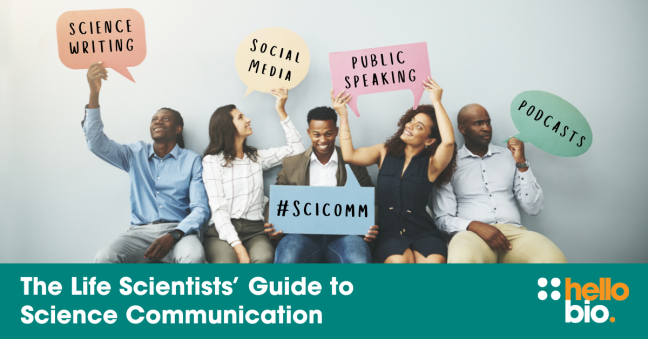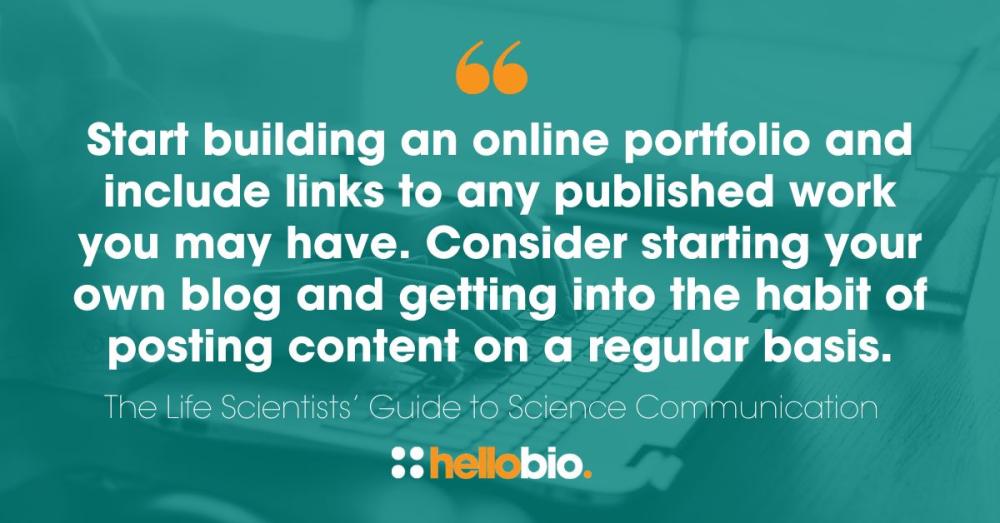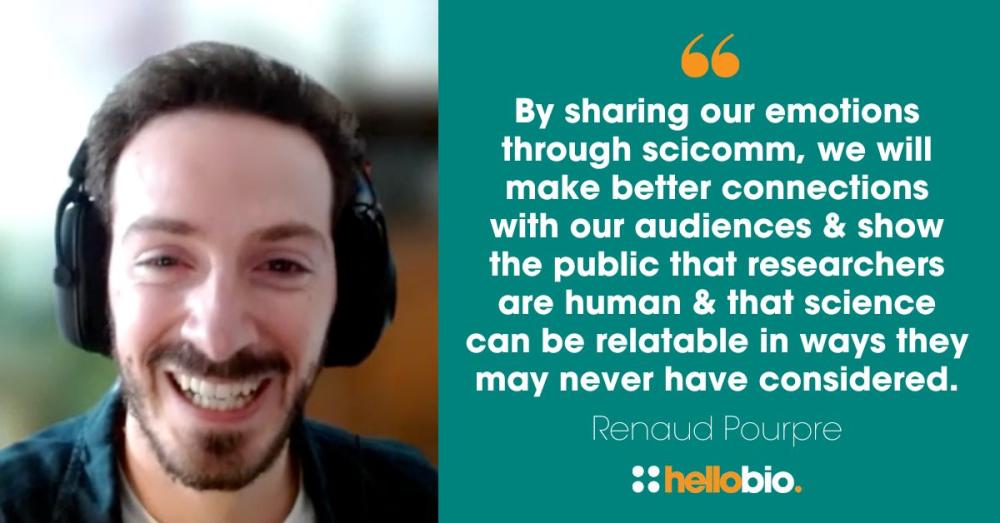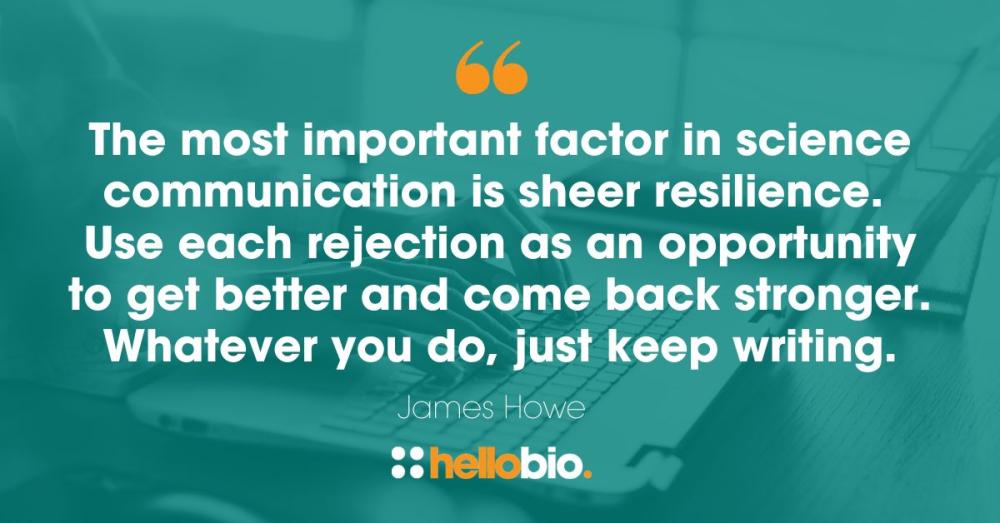The Life Scientists’ Guide to Science Communication
A career in life science requires passion, dedication, resilience and a strong work ethic. However, no matter how successful your experiments, or important your discoveries, without the ability to communicate your science effectively, your great achievements may be overlooked.
Effective science communication is an important skill that all life scientists should dedicate time to learning and developing. Not only does scicomm help to spread the word about all of your hard work in the lab, it also fosters public understanding of science, and can help to inspire the next generation of STEM researchers.
In this guide, we look in detail at some of the key qualities needed for effective science communication, the variety of forms it can take, and how to get published as a science writer. We also share top tips from experienced professionals who know exactly what it takes to get your message out there and become a great science communicator!
What is science communication?
Often referred to as “scicomm”, science communication is the sharing of existing information or new scientific developments in a clear and accessible way. The aim is often to engage with non-scientific audiences who may not express a natural interest or curiosity in STEM research, helping to bridge the gap between the science community and the general public. Scicomm can take a variety of forms including written articles or online blogs, video or social media content, creative arts, games, podcasts or in-person activities such as outreach events or public speaking.
Why is it important?
Scicomm is essential for sharing information and building public understanding of issues that are relevant to society, such as climate change or public health. In recent years the importance of scicomm has grown significantly in the wake of the COVID-19 pandemic, and the subsequent rise of misinformation online. Good science communication helps to rebuild trust in scientists and their research, which is so often damaged by conspiracy theorists or those seeking to win political arguments.
Science communication also plays an important role in influencing policymakers by providing evidence-based information which aids decision making. It can also ensure that more funding is directed to particular fields of research which might otherwise be overlooked, and increases the overall levels of scientific literacy in society.
Why should I get involved?
Being involved in science communication is not only important for the reasons above, it’s also great for your professional development and the advancement of your career. Not only will you gain valuable new skills, you will be giving yourself and your work a public platform which can help to secure funding or lead to useful collaborations with others.
It’s also a great way to inspire the next generation of scientists and motivate young people to consider STEM subjects as possible careers. Expressing your passion and enthusiasm for science can have a huge impact on others, and the more connections we can make with non-scientific audiences, the brighter the future will look for science research.
Dr Chinmaya Sadangi, founder of the science communication platform, The Addictive Brain, shared his thoughts on The Importance of Science Communication. He told us: “Establishing your presence in the science communication world has numerous benefits: enhancing your career, building networks, increasing your knowledge portfolio, and spreading the reach of your work beyond your colleagues. The more we talk about science to a variety of different people, the more we’re working towards building a community that helps non-scientists understand the nuances and complexities of science and its importance.”
Becoming a great science communicator
So what are the key qualities needed to become an effective science communicator? The ability to write about science is something most life scientists practise regularly when producing work for journals, grant applications or their PhD thesis. Being able to write well is essential, but there are many other qualities to consider when working on your scicomm skills:
Key skills & qualities
- Knowledge - To communicate your science effectively, you need to be knowledgeable about your chosen subject. Be confident that the information and ideas you are putting across are both accurate and fair.
- Focus - Think hard about the messages you want to convey and who they are aimed at. Focus on your desired audience and how best to engage with them.
- Clarity - It’s essential that you learn to communicate clearly and concisely in order to connect with a non-scientific audience. Keep things as simple as possible while making sure you include all the essential information they might need.
- Storytelling - Learn to express your science with a strong narrative that makes the information easy to follow, as though you are telling a story. Not only will your audience be more engaged with your work, they will be more likely to remember the messages behind it.
- Creativity - Think outside the box when it comes to your communication style. Make your work as engaging as possible by being creative and expressive.
- Passion - Express your passion and enthusiasm for your topic. The more excited you are about your science, the more excited your audience are likely to be to hear about it.
Have a strong online presence
Build up a strong online presence to promote yourself and your work. Consider creating your own website where you can post examples of your scicomm work. Start building an online portfolio and include links to any published work you already have, which could include newspaper articles or blog pieces. If you want to get into science writing, start your own blog and get into the habit of posting something on a regular basis, eg. daily or weekly. If you prefer to communicate via public speaking, share videos clips of any talks or presentations you have given, podcast or video interviews, and TV or radio appearances.
Use social media to promote your work and connect with others. Online networking platforms such as LinkedIn are commonly used by life scientists to make connections with like-minded researchers. Don’t be afraid to promote yourself and your work online as much as you can. For more advice on this topic, take a look at The Life Scientist’s Guide To Promoting Yourself and Your Work which is packed with tips on putting yourself out there with confidence and learning to shout about your science successes.
Learn more about scicomm
If you want to take your scicomm skills to the next level, there are numerous online and in-person courses and qualifications you can take which will add prestige to your scicomm CV. There are also events, conferences, clubs and social groups you can attend which specialise in bringing scicomm specialists together. You could even start your own scicomm club at your institution or workplace! Take a look at the following for scicomm ideas and opportunities:
Events & conferences
- Science Talk - annual US scicomm conference organised by the Association of Science Communicators. Read more about it here: Improving Your Science Communication Skills
- World Conference of Science Journalists - specialist conferences and workshops from the WFSJ
Professional networks & associations
- BIG STEM Communicators Network - UK-based network for individuals involved in scicomm. Running regular events, training courses and offering networking opportunities.
- PCST Network - an organisation promoting discussion on the theory and practice of communicating science, and organising conferences, symposia and webinars.
- National Association of Science Writers - US-based community of scicomm journalists, authors, editors, producers, public information officers and students, established in 1934.
Courses & qualifications
- FutureLearn: Science Communication & Public Engagement - online course (3 weeks)
- Science Communication: Masterclass - in-person course at UWE Bristol, UK (4 days)
- Effective Science Communication - short online course from Nature Journal
- The Art of Science Communication - online course from the American Society for Biochemistry and Molecular Biology (8 weeks)
Top tips for science writers
If writing about science is your passion, there’s lots of help and advice out there for pursuing a career as a science writer. We’ve gathered some top tips from experienced science writers to help you hone your skills and produce exciting and engaging content!
1. Know your audience
Understanding exactly who you want to communicate with is probably one of the most important things to consider when writing about science. Much of scicomm is intended to engage with a wider public audience, but you may also be hoping to get an important message across to other scientists, members of the media, or even policymakers. Understanding who you are writing for and how to adapt your approach is vital for your communication to be effective. Dr Matthew Lloyd, a senior lecturer at the University of Bath told us: “It’s important to consider who your intended audience will be. Will you be targeting experts in a particular field, or writing more generally for a wider audience? This should be reflected in your writing style and format… when you understand who it is you are writing for… you’ll be able to direct the message of your writing to your desired audience.”
2. Collaborate with others
You might find it helpful to work with other writers on collaborative pieces in order to exchange ideas and get the creative juices flowing. As with scientific papers, scicomm articles or blog posts can be co-written by multiple authors, and it can be a great way to learn new skills and writing techniques from each other. In his video interview with us, Renaud Pourpre of The Lonely Pipette podcast told us why he’s passionate about creative collaboration in scicomm: “I believe that finding people who share your vision, your values, and your methods of communicating your science, and doing it collaboratively is a great way to get started. You will feel supported, you will have more creativity, and you will have complimentary skills and approaches which could help to take your scicomm projects further, faster.”
3. Express your emotions
Renaud also told us why we shouldn’t be afraid to add expressions of emotion into our scicomm writing. Scientific research can often be stereotyped by the public as 'clinical' or 'robotic', but exposing the real heart behind the science can go a long way towards deeper engagement. He told us: “As scientists we strive for robust data that is unaffected by emotion, but often our reason for doing the science is driven by our feelings and values. Research can be motivated by anger or injustice, or by empathy and the need to find solutions for pain and suffering. I truly believe that if we share these emotions through science communication, we will make better connections with our audiences, and show the public that researchers are human, and that science can be relatable in ways they may never have considered. Science is everywhere and we can all be connected to it through our emotions.”
Getting published (and paid!)
Once you’ve built up a strong portfolio of scicomm writing and you’re confident that you’ve found your voice, you might start looking for paid publishing opportunities. The competition can be fierce but it’s worth making connections with newspaper and magazine editors who regularly publish science pieces to let them know who you are and what you have to offer. In this great guest blog, James Howe of the University of California, San Diego shared how he made the jump from hobby writer to published scicomm journalist. He reinforced the importance of having a good online presence, using social media to your advantage and learning how to pitch your work to the right outlets. He also explained why making online connections is key to finding unique opportunities which might not be advertised elsewhere. He said: “Editors from nearly every outlet across the board will occasionally look to solicit new pitches on Twitter. These calls on social media represent unique opportunities: most of these do not get posted on more official channels, and many of these editors are otherwise nearly impossible to reach for someone that’s not already working with them. If you get lucky, these calls can potentially get turned into articles or even a foot in the door for more writing further down the line.”
Just keep writing
James also stresses the importance of resilience and being prepared for rejection in the early stages, something most scientists will already be all too familiar with. He said: “Most of your first attempts to get articles out will go nowhere. Your messages will disappear into inboxes, never to be replied to. That’s totally normal, and I would even consider these events rites of passage. The most important factor in science communication is sheer resilience. Use each rejection as an opportunity to get better and come back stronger. Maybe that pitch better fits a different outlet, or maybe its first sentence could use a bit of re-working. Whatever you do, just keep writing.”
Read the full article by James Howe: How Do You Get Started In Science Writing?
Write for Hello Bio!
Of course another great way to get your science writing in front of thousands of eyes is by submitting a guest article to Hello Bio. Our popular blog has been running for over 7 years and is packed with fascinating articles, advice pieces, science stories and much more from our wonderful guest bloggers. We are always looking to amplify the voices, ideas and opinions of life scientists, and some of our articles have had tens of thousands of views, like this one on gender bias by Kay M. Tye. If you’d like to share an article with us, please contact us via social media or email: hello@hellobio.com
Let’s talk about science
If writing isn’t your thing, remember that there are numerous other ways to communicate your thoughts and ideas about science. Scicomm can take many formats, from verbal to visual, from artistic to ‘out of the box’ - there are lots of alternative ways to get into science communication!
Podcasts
Maybe your passion is for podcasting! Science-themed podcasts have become hugely popular over the last few years and there are lots out there which cover a huge variety of STEM topics. Natural conversations and audio discussions with other scientists are a great way to go deep into specific topics in a real and authentic way. Dr Elodie Chabrol of the Under the Lab Coat podcast recently shared her top tips on starting a science podcast, in this excellent guest blog: Listen & Learn: How to Start Your Own Science Podcast. She encourages budding podcasters to choose a subject they are truly passionate about, to enjoy the process, and to just have a go! She said: “To start a science podcast, you don’t need expensive equipment to produce audio of reasonable quality. If you’re starting with a low budget, try some very basic recording equipment and consider using free audio enhancement software or apps to improve the recording afterwards. Mobile phone microphones will have sufficient quality for attempting your first recordings. You can even connect a headset with a microphone to your phone or computer and, in a well soundproofed room, record your first episode.”
If you need a little more inspiration, take a look at our ‘Podcasts by Scientists’ series in which we chat to creators of science-themed podcasts to find out more about what they do! Here are ten great ones to get you started: 10 Great Podcasts by Scientists
Social media
Many scientists are successfully using social media to communicate their work in a variety of innovative ways. Perhaps the fastest-growing formats are the video-based platforms such as TikTok, which allow scientists to present their messages through snappy and eye-catching videos. Instagram is also a useful space to share colourful graphics, photos and video reels which have huge appeal to younger audiences. There are also more ‘traditional’ social media platforms such as X (formerly Twitter), LinkedIn and Facebook which many scientists use to share and promote what they do amongst their own professional networks.
If you want to find out more about promoting your work and communicating science through social media, take a look at the following articles on the Hello Bio blog:
- 10 Twitter Tips for Life Scientists
- Ten Scientists to Follow on TikTok
- Ten Life Scientists to Follow on Instagram
- Ten Inspiring Neuroscientists to Follow on LinkedIn
- How Early Career Life Scientists Can Use Social Media Effectively
Public speaking & outreach events
If you feel more suited to face-to-face communication, consider getting involved in outreach events or volunteering to speak at public science meetings or conferences. There are many great opportunities such as the annual Pint of Science festival which connects scientists and researchers with the general public in relaxed and informal environments, which can be a brilliant way to engage. Dr Elodie Chabrol told us how volunteering with PoS events motivated her to become much more involved in scicomm: “It’s a fun way to engage with the public and share your research and your life as a scientist. Before PoS I didn’t do any science communication. I organised events and conferences, but I never communicated to the public about my work. I realised that I never really talked about my work – so I started doing it and loved it. Now, I train scientists to talk to the public, and all my experience comes from Pint of Science talks!”
For more on public engagement and how it could benefit your science career, take a look at this great guest blog by Soraya Meftah: Public Engagement: Why Bother as a Scientist?
Many scientists will have experience of presenting posters at scientific meetings or conferences, which are a great way to practise your verbal scicomm skills. For more formal public speaking opportunities you could consider giving audience presentations at science conferences, visiting schools and colleges to speak to young people about STEM, or even taking part in TED-style or TEDx events. Check out some great examples here: Our Top 10 TED Talks by Life Scientists
Dr Emily Grossman is an author and professional science communicator who has given some great advice on presenting science research with confidence. In her recent interview with us, she told us why shifting outdated stereotypes and negative perceptions of scientists and STEM research is essential for enthusing the next generation of researchers. She told us: “It's important that we change the outdated and damaging stereotype that all scientists are old white men in lab coats. Young people today need to see a variety of STEM role models who are just like them.”
Take a look at our review of Emily's ENCODS 2019 presentation workshop, which is packed with expert advice on presenting your research with confidence: How to be a Brilliant Science Communicator.
And for more tips on poster presentations and speaking at conferences, take a look at these other fantastic resources on the Hello Bio blog:
- Tips for Poster Presentations at Scientific Meetings and Conferences
- Tips for Oral Presentations at Scientific Meetings and Conferences
The future of scicomm is yours
In a fast-changing digital age, scicomm is likely to evolve into even more creative and innovative forms over the coming years. It’s an enriching and rewarding activity that will only benefit you as a scientist and as a person, and learning to communicate your science effectively will have a positive effect on the credibility and importance of your research. Finding ways to engage and connect with a non-scientific audience isn’t always easy, but if you can get it right, the impact can be enormous. Renaud Pourpre reminds us about the importance of connection: “Instead of trying to fill people with lots of knowledge and heavy data, we should be trying harder to connect them with the topics in question. If we raise sufficient curiosity and wonder, it can create a spark which will trigger more STEM-based conversations with family, friends, etc. We’re not trying to make them into experts, but if we can at least get them curious enough about the topic to share their thoughts with others, there will be more societal conversation about science, which is always a win.”
More about scicomm on the Hello Bio blog
Read more about scicomm and science writing in these inspiring articles from guest writers on the Hello Bio blog:
- The Importance of Science Communication
- Public Engagement: Why Bother as a Scientist?
- How Do You Get Started In Science Writing?
- Improving Your Science Communication Skills
- Listen & Learn: How to Start Your Own Science Podcast
- How Early Career Life Scientists Can Use Social Media Effectively
- 10 Twitter Tips for Life Scientists
Watch the full video interview interview with scicomm expert Renaud Pourpre on our YouTube channel here:
_________________________________________________
If you enjoyed this article, why not check out the other resources available on our blog. We are passionate about supporting life scientists including early career life scientists and PhD students - with really low-priced reagents, antibodies and biochemicals, early career scientist grants, and resources to help with both personal and professional development. We know how tough it is - so we hope you find these helpful!
More General Support for Life Scientists
For advice on wellbeing, dissertations, presenting at conferences, wellbeing, PhD support, networking and lots more, we have a huge range of articles to help - just click below:
Save up to 50% on our high purity reagents...
When you get to the stage of planning your experiments, don't forget that we offer a range of low-cost, high-purity agonists, antagonists, inhibitors, activators, antibodies and fluorescent tools (yes - they really are around half the price of other suppliers!) You can use our Quick Multi-Search Tool to search for lots of products in one go, and the range includes:
- Enzyme inhibitors and activators
- Chemogenetic ligands
- Ion channel modulators
- GPCR & ionotropic receptor ligands
- Cell biology reagents & biochemicals
Technical resources
Try our Molarity Calculator: a quick and easy way to calculate the mass, volume or concentration required for making a solution.
Try our Dilution Calculator: an easy way to work out how to dilute stock solutions of known concentrations
We also offer a comprehensive range of technical resources including antibody protocols and methods, product guides and mini-reviews:
And finally, don't forget to check back in with our blog regularly for our latest articles. If there’s something you’d love to contribute to the community, whether that’s an interview or article, drop us a line at hello@hellobio.com
---

























